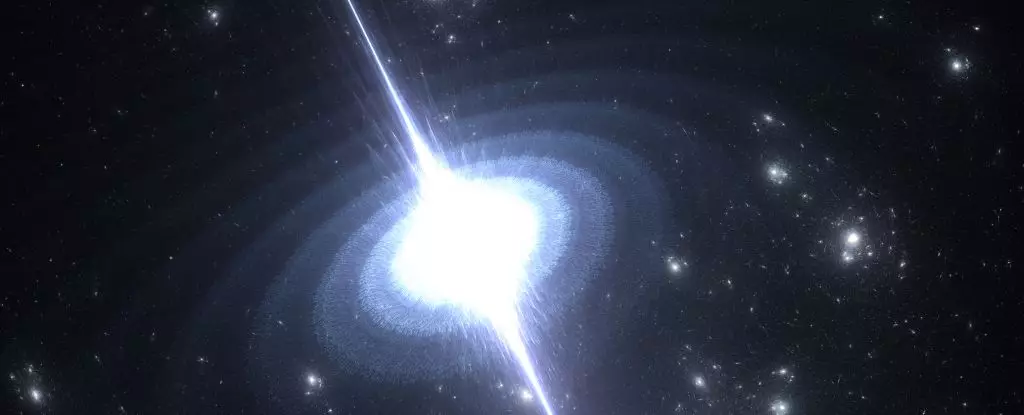In the ever-expanding universe of particle physics, few topics have garnered as much intrigue and speculation as the hypothetical particle known as the axion. Hypothesized in the 1970s, axions could potentially unravel some of the cosmos’s most profound mysteries, including the nature of dark matter. Recent studies have postulated that neutron stars, particularly those spinning at incredible rates, may be prime candidates for axion production. This article delves into the fascinating interplay between neutron stars and axions, shedding light on the potential implications for our understanding of the universe.
Axions, though theoretical, hold the promise of addressing some of the most perplexing questions in astrophysics. These elementary particles are presumed to have a weak interaction with other forms of matter, making them challenging to pinpoint. Nevertheless, axions occupy a unique position within the theoretical particle physics landscape due to their potential role as dark matter. If they exist within a specific mass range, their behavior could mimic that of dark matter, which has historically baffled astronomers with its pervasive gravitational effects that seem to defy the observable matter in the universe.
The detection of axions would not only validate theories surrounding dark matter but could also provide insights into fundamental physics. Theoretical models suggest that axions could decay into pairs of photons in the presence of strong magnetic fields. Thus, discovering extra light emissions near powerful magnetic sources might signal the presence of these elusive particles.
Neutron stars, remnants of massive stars that have undergone supernova explosions, serve as unique natural labs for studying extreme physical conditions. These stars are astonishingly dense, with their cores collapsing into matters so compressed they resemble a single atomic nucleus the size of a city. The magnetic fields generated by neutron stars are among the strongest in the universe, trillions of times more potent than Earth’s, creating an environment ripe for potential axion production.
Particularly intriguing are pulsars – a subclass of neutron stars that emit beams of radiation as they rapidly spin. This rhythmic emission creates a lighthouse effect in space, allowing scientists to observe their pulsing signals. The combination of intense magnetic fields and rapid rotation makes pulsars key players in the axion investigation, as the process of axion trapping could yield valuable clues about their characteristics.
The Research Landscape: Searching for Axion Signals
Despite the strong theoretical foundation supporting axion existence, empirical evidence remains elusive. Recent analyses of various pulsars have yielded no detectable signatures indicative of axion presence. However, this absence of data is not a dismissal of their existence; rather, it suggests stricter limitations on the signals axions might produce.
A recent study proposed a new perspective on this search, positing that axions might accumulate near pulsars over remarkable timescales, potentially leading to the formation of axion clouds. These clouds, which could be common among neutron stars, would produce faint but identifiable photon emissions. The density of these axion clouds is postulated to be astronomical—twenty orders of magnitude greater than local dark matter density—potentially allowing for detectable signatures as photons escape the gravitational grip of the star.
Researchers have conjectured two primary forms that axion-related emissions could take. The first is a continuous signal, expected to manifest as a narrow line in the radio spectrum corresponding to the axion’s mass. While the exact mass remains elusive, the detection of this signal—or the absence thereof—could refine our understanding of axion properties.
The second scenario forecasts a burst of light corresponding to the eventual death of the neutron star, a process projected to span trillions of years. Given the universe’s relatively young age, immediate observational opportunities regarding axion bursts from dying neutron stars remain unlikely.
The Future of Axion Research
Although recent studies failed to find confirmation of axion clouds around nearby pulsars, they nonetheless provided essential constraints on the mass of axions without defaulting to the assumption that they constitute dark matter. This research marks a critical advancement in the search for axions, opening new avenues for exploring properties and behaviors of these mysterious particles.
As our understanding of the universe deepens, the quest to unveil the secrets of axions and their relationship with neutron stars continues, keeping alive hopes that someday we may detect them and, in doing so, unlock the door to new realms of physics and cosmology. The exploration of neutron stars remains a testament to the insatiable human curiosity that drives scientific discovery, pushing the boundaries of what we know about our universe and our place within it.


Leave a Reply